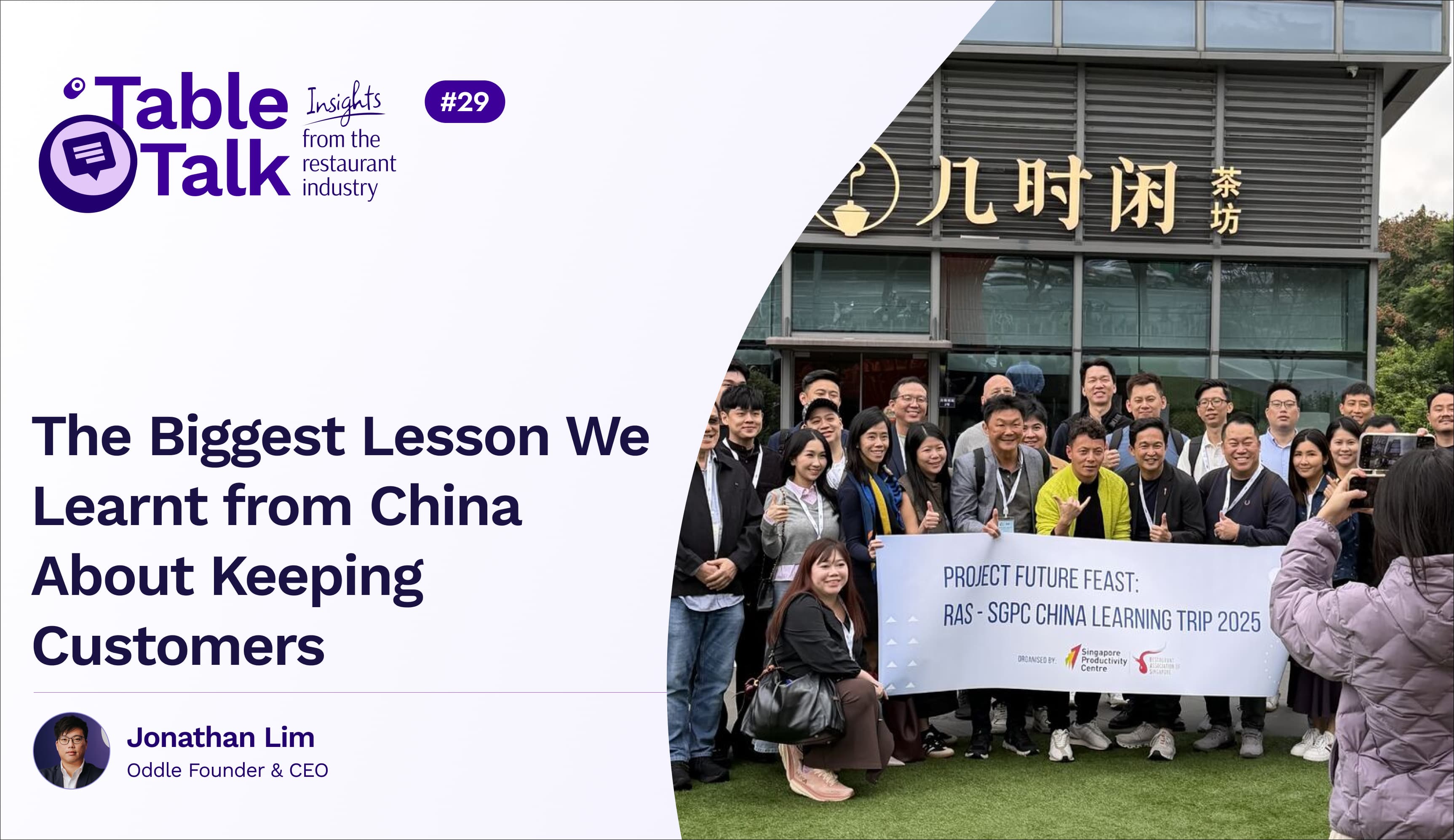The Biggest Lesson We Learnt from China About Keeping Customers
After studying top F&B brands in China, we found out what really brings customers back.

From the Desk of Jonathan Lim, Founder & CEO, Oddle
Last week we talked about creating a customer.
This week is the uncomfortable truth: keeping the customer is much harder than we think.
Most restaurant owners assume that good food naturally brings customers back. I used to think the same. But the data tells a different story. And after speaking with operators in China, it reinforced something I’ve always believed.
Customers don’t return simply because the food is good.
They return because the entire experience makes coming back an easy decision.
And that experience begins long before loyalty points or vouchers.
It starts the moment they walk through your door.
The First Impression Decides Everything
In China, service is not treated as a soft skill. It is treated like production. Every step is broken down: how to greet, where to stand, when to introduce signatures, how quickly to seat a table, and the tone to use when guiding first-time diners.
It may sound mechanical, but the result is the opposite. The customer feels seen. They feel the restaurant knows exactly what it is doing. And that consistency builds trust. Trust builds habits. Habits create repeat customers.
You Only Get One Chance to Put Your Best Dish Forward
One thing that stood out when speaking with Chinese operators was how many of them measure whether staff recommend signature dishes. It makes perfect sense.
A first-time customer gives you one chance. If they leave without tasting your best dish, you may not get another opportunity. Recommending signatures is not upselling. It is respecting your own craft. Your signatures carry your identity. They should always reach the table on a first visit.
The Brutal Reality of Repeat Rates
Let me share a simple example.
A Singapore owner told me proudly that his repeat rate was 30 percent. It sounded high, so we checked. He had only captured 8.3 percent of his diners. Thirty percent of that small group returned. His true repeat rate was closer to 2.5 percent.
And that 2.5 percent was made up of customers who already liked his food enough to register.
This is the part many owners overlook: you cannot keep a customer you never captured.
Across the thousands of restaurants we work with, the real annual repeat rate in Singapore averages around 15 percent. Far from the 40 to 50 percent that some top Chinese brands achieve.
How China Thinks About Loyalty
Chinese operators approach loyalty with a long view. Their goal is to help customers build a visiting habit, not to squeeze a bit more spend out of each transaction.
Their playbook is surprisingly simple:
Visit one: normal price, earn trust.
Visit two: a small benefit to encourage the next step.
Visit three: a bit more, because the third visit is where habit forms.
Lapsed customers: the strongest benefit, because without a push they are unlikely to return at all.
It is rational, practical, and grounded in how people actually behave.
Seasonal Menus Create Reasons to Return
Another thing Mainland operators do extremely well is giving customers regular reasons to come back. Seasonal menus, limited-time items, festive dishes, collaborations, quarterly releases. These act as clear return triggers.
In Singapore, many restaurants keep the same menu for years. The intention is to preserve identity, but customers eventually feel like they have “seen it.” Ironically, introducing fresh items strengthens brand identity because it refreshes the relationship.
A silent menu is forgettable.
A living menu invites customers back.
Data Matters, But Action Matters More
Capturing customer data is important, but the real magic happens when restaurants act on it.
After a customer checks in, do they receive a thank-you message?
Are they reminded about their return vouchers?
Are lapsed customers nudged at the right time?
Are they invited back for seasonal launches?
Do regulars get recognised?
Are birthdays remembered?
The best operators run these actions consistently, not only when business is slow or when there is time. The consistency is what makes the difference. Customers are busy. They are distracted. A simple reminder often brings them back.
Retention Is a Muscle, Not a Mood
One of my biggest learnings from China is this: keeping customers is never about luck or hope. It depends on whether the restaurant builds the systems that quietly do the work every day.
Singapore restaurants have world-class food and strong service. But we tend to fall short in a few areas that matter for long-term revenue: capturing enough diner data, following up on that data, creating structured retention flows, launching regular return triggers, and sending timely reminders. None of these are complicated, but they do require intention.
Good food may create the first visit, but good systems keep the next ten.
And that is where real, compounding revenue begins.
Drucker once said that the purpose of a business is to create a customer. It sounds simple, but it is easy to forget. Many F&B operators jump straight into running operations without first asking: Who is my customer, and what am I really selling?
👀 Curious where your restaurant stands today?
Try BrandCheck — it’s free and shows you how customers (and engines) are finding you.
👉 Get your free brand report:
🇸🇬 https://brandcheck.oddle.me/sg
🇲🇾 https://brandcheck.oddle.me/my
🇭🇰 https://brandcheck.oddle.me/hk
🇦🇺 https://brandcheck.oddle.me/au
📬 Subscribe to Tabletalk: Real stories and hard-earned insights from the frontlines of F&B.